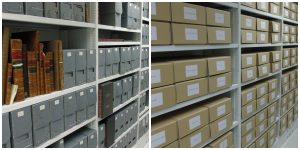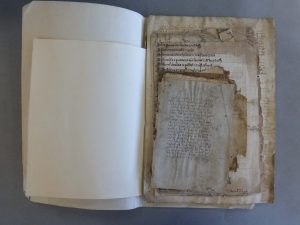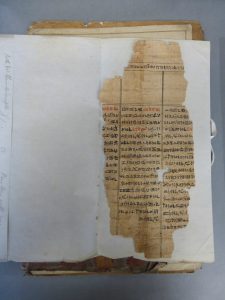In the first post of this two part series, our Collection Care Technician, Robyn Rogers, discusses her Decorated Paper rehousing project. If you want to learn about the uses, production, and trade of decorated paper, you can visit the online exhibition on this collection, curated by Elizabeth Quarmby Lawrence, here. Look out for the second post in this series soon, in which Robyn will discuss mounting loose leaf papers.
Tag Archives: rehousing
Books, Boxes and Bugs! A day in the life of a Collections Care Technician at the Centre for Research Collections
Welcome to our new Day in the Life Series! The Conservation and Collections Management team recently recruited three new members of staff. In this series each of our new team members will give you an insight into life behind the scenes at The University of Edinburgh’s Centre for Research Collections. In this post, our new Collections Care Technician Robyn Rogers discusses what she has been up to since joining the team in March. Expect two more posts in this series, as we introduce our Appraisal Archivist and Archives Collection Manager, Abbie Hartley, and our Collections Management Technician, Jasmine Hide.
My first three months at the Centre for Research Collections have been jam packed – I have installed an exhibition, couriered a loan to the V&A Dundee, cleaned one hundred linear metres of rare books, and rehoused over seventy collection items – and that’s just a small selection of what I’ve been up to! On an average day you might find me jet setting across campus to move a harpsichord at St Cecilia’s Hall, or vising our offsite repository, the University Collections Facility, to clean some especially dirty books, before finishing the day in the Conservation Studio making some phase boxes. I feel fortunate to have worked with many fascinating collection items so far, from a Bible that had been rescued after falling down a well, to 60s pop stars’ microphone of choice. This demonstrates what I love about being a Technician working in cultural heritage – our work focuses on preventative collections care, as opposed to interventive treatment, allowing us to work with an exciting breadth of collections material.
Righting Letters – Conserving the Lyell Collection
Today we have the first installment of a two-part series from Sarah MacLean. Sarah is here on an 8-week internship funded by the NMCT to help with the conservation of the collection of Sir Charles Lyell (1797 – 1875).
As my career in conservation progresses, I find myself drawn most to objects and collections that give insight into the more personal, human aspects of history and heritage. Kings and Queens and famous faces are all very well but I’m more interested in the lives of everyday people – in their passions and machinations, and in how they interacted with the world around them.
Throughout my studies and previous work, I have had ample opportunity to see and conserve this kind of history. Most recently, I worked on the conservation and digitisation of the 1921 Census of England and Wales where I saw first-hand the lives of ordinary people, a snapshot of the nation captured in a single day. And now, as an intern working on the Sir Charles Lyell Collection, I see similar opportunities to preserve and elevate the more unique and personal aspects of the great man’s life.
Sir Charles Lyell (1797 – 1875) was a Scottish geologist and scholar whose discoveries informed a significant shift in our understanding of the Earth and its history. Lyell posited that the geological processes that shaped the Earth are still active in the modern era and through extensive fieldwork, travel, popular lectures, and his best-selling books, he became internationally famous and respected by many scientific communities.
He also corresponded with near-innumerable members of these communities with professional and personal relationships often spanning the entirety of his career in the same way that his precious notebooks do. It is this varied and extensive correspondence that I have been working steadily to conserve and rehouse during my time at the Centre for Research Collections.

A letter from Lyell’s correspondence before and after conservation treatment
This part of the Lyell Collection comprises 22 boxes containing thousands of letters and other documents. Typically, I assess and conserve 1-2 boxes in an average working day and so anticipate completing this work by my 6th week here at the CRC. I re-label each folder of correspondence individually before assessing and conserving its contents as needed. Typically, this work extends to flattening folds and plane distortions, surface cleaning using chemical sponge, undertaking tear repairs, and infilling small lacunae using Remoistenable Tissue (lightweight Japanese paper impregnated with an adhesive that is reactivated with moisture).
My work on the 1921 Census prepared me well for my work on the Lyell correspondence – not only have I built considerable aptitude with my chosen repair material, but I also greatly enjoy the nitty-gritty remedial nature and consistency of the work. However, this consistency and regularity is not to say that the Lyell correspondence has not already yielded some wonderful surprises.
Often, these surprises have come in the form of unique drawings, maps, and other larger format works coloured with an array of aesthetically pleasing pigments. From the coastline of Louisiana to coal deposits in the Scottish Highlands, these works have the potential to tell us not only about Lyell’s working processes and the areas of study he thought most important, but to give greater insight into his personal quirks alongside those of the people with whom he corresponded.

A small drawing showing an erupting volcano illustrating Lyell’s interest in volcanology.
These larger works often pose interesting conservation challenges too. Their scale means that they have been folded to fit their envelopes or other housings and the mechanical stresses this puts on the paper has led in many places to weakness and tears. The repairs that I undertake must not only be neat and visually pleasing but must also be robust enough to withstand handling and consultation as well as the object itself being carefully folded again and returned to its housing.
I have also had the opportunity already during my time at the CRC to tackle Lyell’s collection of geological specimens and discovered a heretofore unknown little example of such a specimen within his correspondence – another pleasant surprise.
Crumpled within a small envelope, I have been unable yet to discover what type of stone these pieces are comprised, but I have been able to rehouse them, encapsulating them in Melinex for the time being so that they can be viewed and consulted without the need for direct handling.

Two small geological samples discovered within an envelope in Lyell’s correspondence.
All the work I have undertaken thus far on the Lyell correspondence has been done with that knowledge that the collection is, at its core, is to be used and learned from. This need for accessibility interests me just as much as the unique and personal stories within Lyell’s correspondence because I believe strongly that the more accessible we are able to make the Lyell Collection and others like it, the greater the impetus will be for such treasures to be preserved and protected in the future.
Crowdsourcing Conservation – Thomas Nelson Collection
Following on from the popular “Crowdsourcing Conservation” sessions held in February 2017 and 2018, the Centre for Research Collections held seven more crowdsourcing events from October 2018 to March 2019. This time, we focussed on the Thomas Nelson collection. Over seven days, 67 volunteers helped to rehouse 197 boxes of archival material. The collections are now stored in acid-free folders and boxes, and are much easier to handle and access.

Thomas Nelson Collection, before rehousing

Thomas Nelson Collection, after rehousing
Store Room Surprises!
Project Conservator, Helen Baguley, describes some of the more unusual objects she has found in our store rooms, and how she has conserved them, in this week’s blog…
One of the most exciting aspects of my role is surveying the collections housed at the Main Library and the University Collection Facility (UCF). This gives me to opportunity to look at collections I would not usually come into contact with, and I get to discover what is in the University’s vast collections. The purpose of these surveys is to determine any conservation work which needs to be carried out to safely house the collections and preserve them for future use. Some of these collections have already been appraised by archivists and some are awaiting appraisal. I create the surveys in Excel and write a report of my findings. The report records the current condition of the collection, lists the types of materials found, gives recommendations for future housing, and provides a cost estimate for the materials needed to carry out the work.
Crowdsourcing Conservation 2018
Due to the success of last year’s ‘Crowdsourcing Conservation’ event, we are repeating the session on 19 and 20 February 2018! You can read more about last year’s event here.
This year, we will continue to work with the Laing collection, this time rehousing section IV. Over the two-day period we aim to rehouse 96 boxes, completing the boxing of the Laing manuscript material.

Boxes from the Laing II collections, before (left) and after (right) rehousing
Damage has been caused to these collections due to the current storage in vertical boxes. Folders have slumped in under-filled boxes, and caused planar distortion of the papers. Tearing and creasing has occurred due to the lack of internal protection. To solve this problem, we want to rehouse the collection in acid-free folders and boxes.
Crowdsourcing Conservation at the CRC
In this week’s blog, Special Collections Conservator Emily, describes the highly successful crowdsourcing conservation event held in February at the CRC…
In February, we held our first ever conservation crowdsourcing event here at the CRC. Over a two-day period, with the help of 24 participants, we aimed to rehouse section II of the Laing manuscripts in acid-free folders and boxes. Laing’s collection of charters and other papers is the University’s most important manuscript collection. Highlights of the collections include letters by Kings and Queens of Scotland and England, poems in the hand of Robert Burns and early manuscripts in Gaelic and Middle Scots. You can find out more about the collection here. The collection was in poor condition due to its housing in unsuitable upright boxes and folders. It was difficult to access and there was a risk of further damage every time it is handled.

Laing II boxes on the shelf, before treatment
Crowdsourcing Conservation
During the Festival of Creative Learning (20-24 February 2017), we will be hosting our first ever conservation crowdsourcing event!
Over a two-day period (20-21 February), with the help of 30 participants, we aim to rehouse section II of the Laing manuscripts – the University’s most important written collection.

Folder from section II of the Laing manuscripts
Laing’s collection of charters and other papers is of national importance and the most distinguished of its kind in any Scottish university. It is an essential resource for the 18th century, however, it is in poor condition due to its current housing in unsuitable upright boxes and folders. It is an extremely popular collection, but it is difficult to access and there is a risk of further damage every time it is handled.
Shooting the breeze
It’s not every day that you are asked to conserve a magic spell on papyrus, but this is exactly what happened when I was asked to take a look an ancient fragment of text, recently discovered in the archive collections at the CRC.
The fragment was unearthed by an archives intern who was assessing the foreign language material in the David Laing collection. A vague catalogue entry labelling the box as miscellaneous languages, and an inscription on the folder wrongly identifying it as Chinese script, meant that this item had not been consulted for years and the staff were unaware of its existence. It has been suggested that it could be an Egyptian spell from the book of the dead, but further research is needed to confirm this.

Fragment of papyrus, before conservation
Boxing Clever
Rehousing is a key part of conservation. But why is it so important? Find out in this week’s blog from Special Collections Conservator, Emily…
We recently received a large number of drop spine boxes to house the Laing Western manuscript collection. This was a part of a month-long project to conserve this collection, which you can read more about by following this link. These boxes are handmade to match the exact dimensions of the book. Not only do they look great on the shelves, they also provide excellent protection for the books. However, they are relatively expensive and time consuming to make. So the creation of these boxes is often outsourced, and reserved for our most important collections.

Laing manuscript collection, before rehousing

Laing manuscript collection, after rehousing
